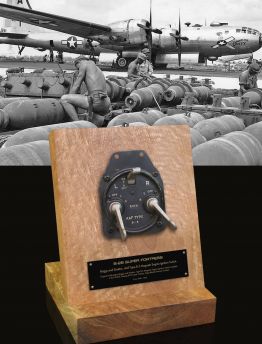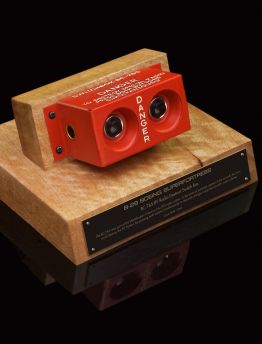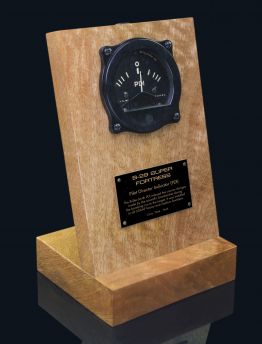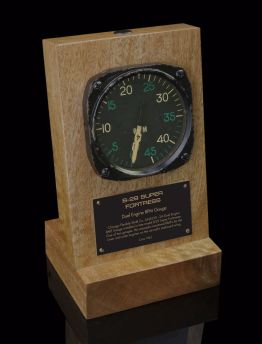- AUST POST SHIPPING
- 0438 654 235
- info@recoverycurios.com
- P.O. Box 7640 Cairns QLD Australia, 4870
-
0
Shopping Cart


B-29 SUPER FORTRESS
 The Boeing B-29 Super Fortress was one of the largest four-engine propeller-driven heavy bombers of the Second World War - continuing to serve with the USAF well into the early 1960s including its deployment as a strategic high-altitude bomber during the Korean War.
The Boeing B-29 Super Fortress was one of the largest four-engine propeller-driven heavy bombers of the Second World War - continuing to serve with the USAF well into the early 1960s including its deployment as a strategic high-altitude bomber during the Korean War.
 One of the most technologically advanced aircraft of its time, the B-29’s state-of-the-art technology included a pressurised cabin; dual-wheeled, tricycle landing gear; and an analog computer-controlled fire-control system that allowed one gunner and a fire-control officer to direct four remote machine gun turrets.
One of the most technologically advanced aircraft of its time, the B-29’s state-of-the-art technology included a pressurised cabin; dual-wheeled, tricycle landing gear; and an analog computer-controlled fire-control system that allowed one gunner and a fire-control officer to direct four remote machine gun turrets.
The $3 billion cost of design and production, far exceeded the $1.9 billion cost of the Manhattan Project making the B-29 program the most expensive of the war.
Originally intended to be used in the European war theatre and then later in the Pacific, production delays and design issues continued to plague the Boeing aircraft right up to its eventual deployment in late 1944, under a plan to operate out of forward bases in southern China against the Japanese homeland.
This was an extremely costly scheme, as there was no overland connection between India and China, and all supplies had to be flown over the Himalayas, either by transport aircraft or by the B-29s themselves, with some aircraft being stripped of armour and guns and used to deliver fuel.
B-29s started to arrive in India in early April 1944, with the first B-29 combat mission flown on 5 June 1944, with 77 out of 98 B-29s launched from India, bombing the railroad shops in Bangkok and Thailand. Five B-29s were lost during the mission, none to hostile fire.
 In addition to the logistical problems associated with operations from China, the B-29 could only reach a limited part of Japan while flying from Chinese bases and the B-29s were ultimately withdrawn from Chinese airfields after US forces overran forward airbases on the Mariana Islands.
In addition to the logistical problems associated with operations from China, the B-29 could only reach a limited part of Japan while flying from Chinese bases and the B-29s were ultimately withdrawn from Chinese airfields after US forces overran forward airbases on the Mariana Islands.
The capture of Japanese held Saipan in July 1944 and the securing of Guam and Tinian shortly after bought targets such as Tokyo suddenly within range of the B-29’s and the islands were quickly converted to strategic air bases large enough to accommodate four bomber groups of 180 B-29’s each.
The bases became the launch sites for some of the largest B-29 raids against Japan in the final year of  the war, with the first combat mission was launched on 28 October 1944, when 14 B-29s attacking the Truk atoll.
the war, with the first combat mission was launched on 28 October 1944, when 14 B-29s attacking the Truk atoll.
A month later the first mission against the Japanese mainland was launched, sending 111 B-29s to attack Tokyo - the first attack on the Japanese capital since the Doolittle Raid in April 1942,
The campaign of incendiary raids started with the bombardment of Kobe on 4 February 1945, then peaked early with the most destructive bombing raid in history on the night of 9 -10 March 1945 on Tokyo. From then on, the raids intensified, being launched regularly until the end of the war. The attacks succeeded in devastating most large Japanese cities and gravely damaged Japan's war industries.
 Perhaps the most famous B-29 raids were those conducted to drop the atomic bombs.
Perhaps the most famous B-29 raids were those conducted to drop the atomic bombs.
Hand-picked straight off the assembly line at the Boeing Omaha plant by Lieutenant Colonel Paul W. Tibbets, two B-29’s were stripped of all guns, except for those on the tail to reduce weight and extend their flying range.
Enola Gay, flown by Tibbets, dropped the first bomb, called Little Boy, on Hiroshima on 6 August 1945. The other B-29, Boxcar dropped the second bomb, called Fat Man, on Nagasaki three days later.
The B-29’s advanced design allowed it to remain in service in various roles throughout the 1950s, retiring in the early 1960s, after 3,970 had been built becoming Boeing’s test bed for later bombers, tankers and recognisance aircraft including the C-97 Stratofreighter and the K-29 air tankers.
 It was a B-29 that carried Chuck Yeager's Bell X-1 aloft to set the world's airspeed record at over Mach 1.
It was a B-29 that carried Chuck Yeager's Bell X-1 aloft to set the world's airspeed record at over Mach 1.
The B-29 also became the unintentional testbed for the Russian Tupolev Tu-4 when a USAF B-29 crashed in to the foothills of Sikhote-Alin Mountain range east of Khabarovsk after the crew bailed out and another was diverted to Vladivostok, Russia, after engine failure.
Both crews were eventually returned to the US but the two B-29’s remained in Russian hands and were reverse engineered to further Soviet long-range bomber technology.
All B-29 Super Fortress Instruments listed below come complete with detailed Scale Model, Mango Wood Stand & Plaque plus Printed Fact Sheet featuring photo of instrument in aircraft cockpit.
Return to VINTAGE ORIGINAL AIRCRAFT INSTRUMENTS
- LAND
- SEA
- AIR
- VINTAGE ORIGINAL AIRCRAFT INSTRUMENTS
- HAWKER TYPHOON
- VICKERS WELLINGTON
- FAIREY GANNET
- RYAN ST-A SPORTS TRAINER
- DE HAVILLAND TIGER MOTH
- HAWKER HUNTER
- Mc DONNELL DOUGLAS KC-10 AERIAL TANKER
- SOPWITH CAMEL
- AIRCO DH.1 AND DH.2
- JUNKERS JU 87
- CURTISS C-46 COMMANDO
- HANDLEY PAGE HAMPDEN
- SUPERMARINE SEAFIRE
- B-25 MITCHELL BOMBER
- BRISTOL BLENHEIM
- ENGLISH ELECTRIC LIGHTNING
- HAWKER TEMPEST MkVI
- YAKOVELOV YAK - 3
- FOCKE-WULF FW190
- FOLLAND GNAT
- AIRSPEED OXFORD
- SHORT STIRLING
- AVRO ANSON
- DOUGLAS C-133 CARGOMASTER
- HANDLEY PAGE VICTOR BOMBER
- DE HAVILLAND SEA VENOM
- VICKERS VALIANT BOMBER
- DOUGLAS A-26 INVADER
- GRUMMAN S2F TRACKER
- SUPERMARINE SPITFIRE
- LOCKHEED P2-V NEPTUNE
- P-51 MUSTANG
- BRISTOL BEAUFIGHTER
- DE HAVILLAND MOSQUITO
- B-26 MARTIN MARAUDER
- P3 ORION
- DOUGLAS A-20 HAVOC
- P-39 AIRACOBRA
- AVRO SHACKLETON
- B-17 FLYING FORTRESS
- B-24 LIBERATOR
- MESSERSCHMITT BF-110
- MESSERSCHMITT BF-109
- BRISTOL BEAUFORT
- KAWASAKI Ki-45 (NICK) INTERCEPTOR
- C-130 HERCULES
- CAC BOOMERANG
- AVRO LANCASTER
- GRUMMAN F4F WILDCAT
- F4U VOUGHT CORSAIR
- WESTLAND LYSANDER
- P-47 REPUBLIC THUNDERBOLT
- NORTH AMERICAN T-6 TEXAN - HAVARD
- C-47 SKYTRAIN
- DOUGLAS SBD DAUNTLESS
- CAC WIRRAWAY
- PBY CATALINA
- P-40 WARHAWK
- FAIREY SWORDFISH
- P-38 LIGHTNING
- HAWKER HURRICANE
- CURTISS SB2C HELLDIVER
- GRUMMAN F6F HELLCAT
- SEAKING HELICOPTER
- SEAHAWK HELICOPTER
- DOUGLAS A4G SKYHAWK
- GRUMMAN TBF AVENGER
- HANDLEY PAGE HALIFAX
- DOUGLAS SKYRAIDER AE-1
- GLOSTER METEOR
- JUNKERS JU-88
- F-86 SABRE JET
- SHORT SUNDERLAND
- B-29 SUPER FORTRESS
- F-9F GRUMMAN PANTHER
- F-100D SUPER SABRE
- BELL UH-1 HUEY HELICOPTER
- AVRO VULCAN STRATEGIC BOMBER
- CANBERRA BOMBER
- DHC-4 CARIBOU
- BLACKBURN BUCCANEER
- DE HAVILLAND VAMPIRE JET
- HAWKER SEA FURY
- LOCKHEED HUDSON
- LOCKHEED EC-121 WARNING STAR
- SEPECAT JAGUAR
- HAWKER SIDDELEY NIMROD
- HAWKER SIDDELEY HARRIER
- ARADO AR 196
- VOUGHT OS2U KINGFISHER
- LOCKHEED ELECTRA
- NORTHROP P-61 BLACK WIDOW
- BOEING CH-47 CHINOOK
- LOCKHEED PV-1 VENTURA
- BOEING P26-A 'PEASHOOTER'
- Ilyushin Il-2 ‘Sturmovik’
- WESTLAND WESSEX
- FAIREY FIREFLY
- VINTAGE AVIATION COLLECTABLES
- VINTAGE COLLECTABLE MODEL AIRCRAFT KITS
- RETRO STYLE METAL AIRCRAFT COLLECTABLES
- VINTAGE ORIGINAL AIRCRAFT INSTRUMENTS





